Sherwood Country Park (Birklands)
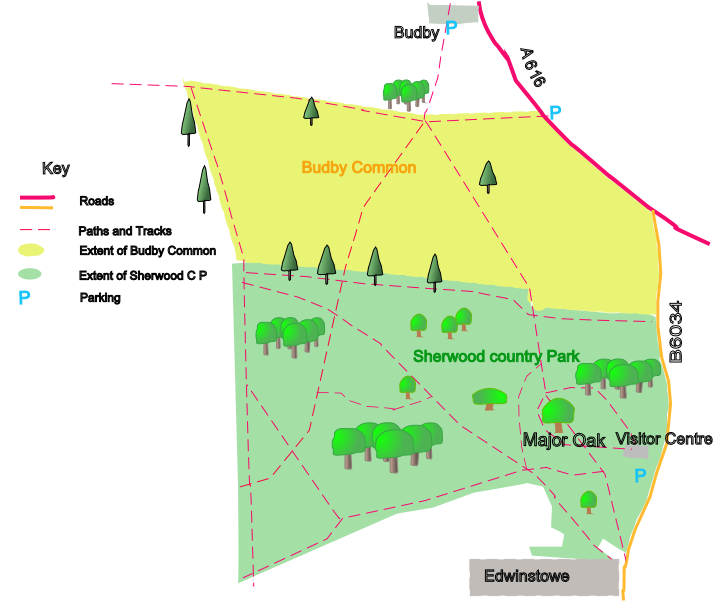
A National Nature reserve (the only one in Nottinghamshire), managed by Nottinghamshire County Council and Forest Enterprise. Also part of the Birklands and Bilhaugh SSSI (Site of Special Scientific Interest). It is also being considered as a SAC (Special Area of Conservation) under European law. It covers about 450 acres.
In the country park is the world famous Major Oak. It is the only tree that I know of that has its own web page! This can be found here.
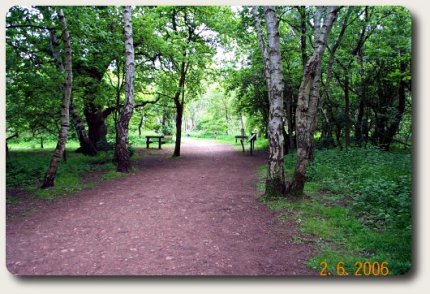
Access and facilities
A car park fee of £3 is charged during school holidays, there is also a season ticket at £20 (which covers Rufford Country Park as well). Parking at other times is free, including weekends. The main car park barrier is open usually between 8.00am and 5.00pm, but parking is possible before the barrier if you arrive at other times. The exit (protected by ‘dragon’s teeth’) is open all the time. The car park by the Edwinstowe fair ground is open all the time. The visitor centre has exhibitions, cafe and toilets.
The Sherwood Arrow bus operates daily from the end of April to the end of September. For other times the visitor centre can be reached by walking from Edwinstowe (10 minutes away) by the Stagecoach service no 14 which runs between Mansfield and Walesby, or the Stagecoach service no 10 which runs from Mansfield to Edwinstowe.
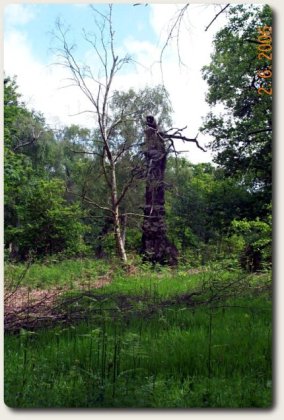
Trails
There are three trails around the park, many surfaced with red shale.
- Blue Band (Major Oak path)
- 1 mile long; goes from the visitor centre to the Major Oak and returns. Well made path suitable for wheelchairs.
- Green Band (Greenwood Walk)
- 1 ¾ miles long; includes young and old oaks, birchwood and heathland.
- Red Band (Birkland ramble)
- 3 ½ miles long; goes around most of the park.
The trails are marked with coloured glass set in wooden posts. If you are not familiar with the forest then following one of these trails is advised. There are also bridlepaths for horse riders and cyclists.
There are plenty of other paths to follow if it takes your fancy, some paths may be closed temporary because of grazing cattle or forestry operations. The cattle have been introduced to help control the undergrowth.
Habitat
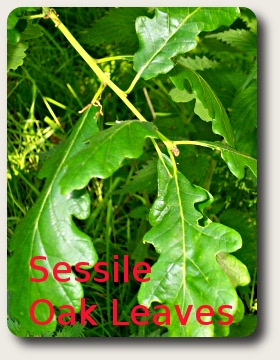
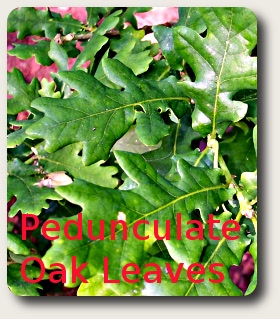
Sherwood Forest (and a lot of the surrounding area) lies on Bunter Sandstone, which gives poor quality acidic soil. The trees are Oak (some Sessile but mainly Pedunculate), Birch, Holly and Rowan, with a sparse shrub layer. The ground layer is usually bracken. Pine plantations are on the perimeters of the park. Management of the area consists of protecting the 500+ large old oaks, removing pine, beech and sycamore trees and replacing them with new plantings of oak and birch. Also being cleared are areas where Silver Birch has formed dense clumps effectively denying the ground to any other vegetation. Dead trees and branches are left where they fall to sustain the forest’s ecology. Scrub and bracken are controlled in the heathland areas. Sessile and Pedunculate Oaks can be identified by their leaves. Sessile Oak tree leaves have a stalk, whereas Pedunculate Oak leaves don't appear to have any stalk at all.
Birds
Best time to visit is during the week in spring. This country park gets lots of visitors, around 500,000 a year. Most of them either remain around the visitor centre or go along the two paths between the Major Oak and the visitor centre, but even at a weekend in midsummer the forest is large enough to have plenty of quite spots.
Chaffinch is easily the most dominate bird in terms of numbers from the early part of the year up to July when many of them move out, but the area has its own specialties like Goshawk, Lesser spotted Woodpecker, Redstart, Tree Creeper, Nuthatch, Marsh Tit and Jay.
Tree Pipits can be heard in the late spring and summer in the more open heathland areas, but Budby Common (just to the north) is a lot better for this species. Redstarts can be seen in the more open Oak areas, and in May can be found by listening for their song which is delivered from the top of the tree. Willow Warblers are more common here than in most of Nottinghamshire. Marsh Tits can be seen on most often on the Blue footpath (as can Lesser spotted Woodpeckers). The typical drumming of a Lesser spotted Woodpecker is longer (a second plus) with slower individual taps than the machine gun burst of the Greater spotted. The effect is to give an impression of a second of two or rapid ‘tapping’ rather than the Great spotted’s rapid strikes which merge into one another. Here is a recording of a Lesser spotted Woodpecker drumming, and for comparison here is the Great spotted Woodpecker. Green Woodpeckers prefer the more open heaths with their abundant ant colonies. Nightjars "churr" on the open heathlands on summer evenings.
Other Animals
The most obvious mammals are the Grey Squirrels which are seen everywhere. The next most obvious is the mole (or rather the mole hills). In reality Woodmice, Field and Bank Voles, Common and Pygmy Shrews are far more numerous but not often seen.
Sherwood carries a large variety of spiders – over 200 species – Orb web spiders like the Garden and Telegraph spiders, sheet web spiders, jumping spiders such as the Zebra spider and hunting spiders, like the Wolf spider. There are even more species – over 1500 – of Beetles.
Budby Common (Budby South Forest)
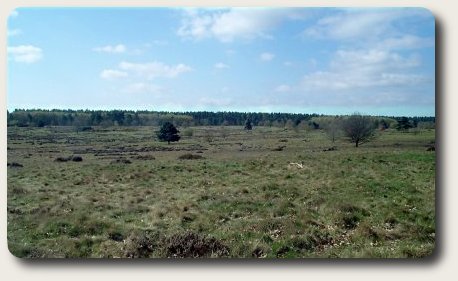
Budby Common goes under several name, Budby South Forest and Budby Heath are two others. Budby Common is owned by Thoresby Estates, leased by the Ministry of Defence as a training area and exercises still take place here. It is managed jointly by English Nature and the MoD. It is thanks to the MoD that the land is as it is, otherwise it would be just another carrot field. Budby Common is really a misnomer—it has never been common land.
Access
There are plenty of public footpaths which cross the common and are well marked. Access can be from the Sherwood Country park, Budby village or by parking in the limited area on the A616. The common is a limited access CROW (Countryside and Rights of Way Act).
Habitat
The habitat is mainly heathland with some scattered birch and Scots Pine. Parts of the heathland have been fenced off so grazing animals can be kept on the heath. The idea of having grazing animals (usually sheep) present is to control the bracken and grass and to permit the heather to flourish in the more open areas. Silver Birch is also controlled to keep the heath from becoming woodland.
Birds
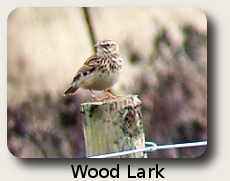
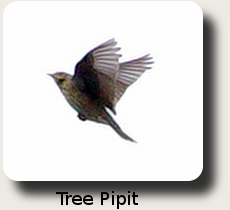
In winter has held up to two Great Grey Shrikes, but more often no birds are present, Stonechats are more often to be seen. In the summer Willow Warbler, Wood Lark, Tree Pipit (20+ pairs) and Nightjar breed. Recently the number of Nightjars and Woodlarks has reduced somewhat. Common Crossbills can be seen in the pines periodically at any time of the year. Other birds to be seen at any time of the year are Kestrel, Green Woodpecker, Skylark, Meadow Pipit, Jay, Linnet and Yellow Hammer.
Updated 23rd March 2012Any criticisms, corrections or comments to the author Derek Huskisson

This work is licensed under a Creative Commons Attribution-Noncommercial-Share Alike 2.0 UK: England & Wales License.